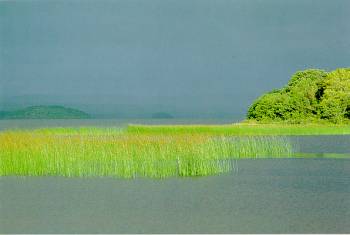
The Lough Melvin Trout

|
Lareen Bay, Lough Melvin. Though the lake lies close to Donegal Bay and the Atlantic Ocean, sea trout are scarce in comparison to the three resident freshwater varieties. |
Though not the most famous of the Irish loughs, Lough Melvin is certainly the most special so far as wild trout are concerned, for the waters are inhabited by five different varieties: the brown trout, sea trout, gillaroo, ferox and one form unique to this lake: the sonaghen. These varieties share the lough with other native fish including the Atlantic salmon, char and eel, as well as the perch and rudd, which were introduced by man.
Lying on the border of the Republic of Ireland and the United Kingdom province of Northern Ireland, the lough is about 7½ miles long and up to 2 miles wide with its long axis lying cast-west. Water leaves the western end of the lake to flow down to the Atlantic through the Drowes River and is replaced by the inflowing rivers - the Tullymore, Roogagh, County, Ballagh and Glenaniff – that drain the surrounding countryside and enter the lough on the eastern shores.
Over much of the western half and around the skerries and islands of the northeast, the lake is quite shallow at up to about 33 feet deep. By contrast, in the wide open basin of the southeast, between Ross Point and Breffni Pier, and extending as a trench northwestwards between the islands of Inisheher and Inishmean and the northern shore the water is much deeper, reaching a maximum depth of 150 feet.
To the south of Lough Melvin the land rises rapidly through woodland and rough pasture to hills reaching over 1300 feet, while on the cast and northern sides the catchment consists mostly of lower-lying pasture and woodland. The water that drains this area and enters the rivers and thence the lough has very little added in the way of artificial fertilizers: most of the mineral salts in the lake are acquired naturally from the soil.
Like the other Irish loughs, Melvin was formed during or after the last Ice Age, so the wild trout must have colonized its waters via the sea and the Drowes River. Today, sea trout are quite scarce in Lough Melvin compared with the four lake varieties; in some Irish loughs such as Corrib and the Scottish lochs they are abundant.
The four forms of lake trout in Lough Melvin have been the subject of a recent (1977-1984) study by Andrew Ferguson and his co-workers in the Department of Zoology at the Queen's University of Belfast. After examining hundreds of specimens, and applying the technique of gel electrophoresis ('genetic finger-printing') they concluded that the gillaroo, sonaghen and ferox constitute three genetically distinct varieties of trout; while the form that has for years been referred to as 'brown trout' appears genetically to be either gillaroo or sonaghen that has not, for some reason, attained its full characteristics.
|
|
|
|
|
|
|
Logh Melvin's three distinct
wild trout varieties show considerable differences in size,
shape and colour. |
So different genetically are these three varieties that Ferguson and his colleagues suggested that they could be considered full trout species.
The genetic differences between the three varieties are reinforced by ecological separation: the gillaroo, sonaghen and ferox occur in different parts of the lough and feed on different sorts of prey; and they also spawn in different areas so that there is no interbreeding between the three forms. All the gillaroos spawn in the River Drowes or Loreen Bay, All the sonaghens breed separately in the small feeder streams of the lough, especially the Ballagh, County and Tullymore rivers. And the ferox trout move from the lough into the River Glenaniff where most of the Melvin Atlantic salmon also spawn.
The other large loughs of Ireland have subtle, but important differences from Melvin: their fish stocks have been more tampered with by man. In some cases this has been quite inadvertent: more intense agriculture in the catchment area, notably the addition of large and regular doses of artificial fertilizers which are readily leached into the lake, has enriched the water, increasing the production of plant and animal life, and affecting the trout population.
In other cases the interference has been conscious. In some loughs over-fishing (especially with nets) with or without artificial stocking has certainly spoilt the genetic structure of the trout populations. The effect has been exacerbated by adding a wider range of introduced fish species to most loughs: especially the pike. This fish-eating predator, which is very fond of salmonids, is likely to have affected the structure of the trout populations in many lakes.
Gillaroos (or, at least, trout resembling gillaroos) still occur in some other lakes, such as Lough Conn in County Mayo. So do ferox-type trout. Sea trout, together with salmon, still run from the Atlantic into many loughs. But if sonaghens ever existed in the other big Irish loughs, they certainly do not today. These other big loughs contain large numbers of brown trout, and the productivity of the water results in a rapid growth rate; so the angling is quite spectacular, attracting visitors from around the world.


